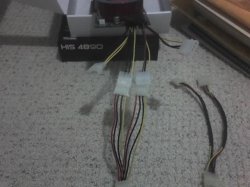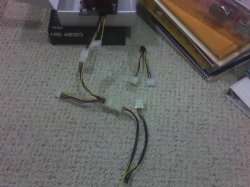i hate electricity
LOL
Thank you. "What's going on down there" is what is pictured on the left or first below - 2 molex plugs, one from each of the 6-and 8-pin cables, plugged into the first of the 2 molex splitter cables... both ports on that first splitter filled. The second splitter would be used only as an extension to get the one end (at bottom of image) up to the optical bay. It is as ghetto as it looks... and in retrospect sounds (and looks) like a bad idea.
But that was my question; you're recommending I plug both the 6-pin cable into the mo-bo normally, and plug in the 8-pin cable, and then use only one molex split from the 8-pin cable to go up to the optical bay? That would be the second image below (8-pin filled with 8 pin -> 2 molex, and then the 6-pin to molex split not used at all laying off to the right, and 6 pin not filled because i didn't yank out the 6-pin mo-bo cable)... Does that look correct? I sense that the lifespan of this card is not so long in my hands.
Plug the 6-pin into the motherboard. Take either the 8-pin or 6-pin (honestly, it doesn't matter one bit) and then plug in one of the molex plugs into the second optical drive power plug-in. I wasn't able to do that without removing the optical drive itself and having it sit on a stack of books outside the machinebut you could always grab an extension cable if you don't want to wait a week for ATI to ship you another 6-pin PCIe cable.
The discrepancy in how I had the card comes from this: at the time of the earlier post, that was how I had it. At the time of the pictures I'd posted, I'd received my new power cable from ATI and was using that. No, your card isn't the same as mine - you have the Turbo edition, mine is similar but has the standard clock.
Yes, I put a 6-pin PCIe cable into an 8-pin slot. No power issues at all, it runs exactly the same as it did when I was using the molex cable. Both the PCIe cables are attached to the motherboard - if you'd like more pictures I can take them.
It looks like from the picture you've posted that you have the cables plugged into the molex adapters properly, but I can't see the other end of them so who knows what's going on down there.
LOL
Thank you. "What's going on down there" is what is pictured on the left or first below - 2 molex plugs, one from each of the 6-and 8-pin cables, plugged into the first of the 2 molex splitter cables... both ports on that first splitter filled. The second splitter would be used only as an extension to get the one end (at bottom of image) up to the optical bay. It is as ghetto as it looks... and in retrospect sounds (and looks) like a bad idea.
But that was my question; you're recommending I plug both the 6-pin cable into the mo-bo normally, and plug in the 8-pin cable, and then use only one molex split from the 8-pin cable to go up to the optical bay? That would be the second image below (8-pin filled with 8 pin -> 2 molex, and then the 6-pin to molex split not used at all laying off to the right, and 6 pin not filled because i didn't yank out the 6-pin mo-bo cable)... Does that look correct? I sense that the lifespan of this card is not so long in my hands.




